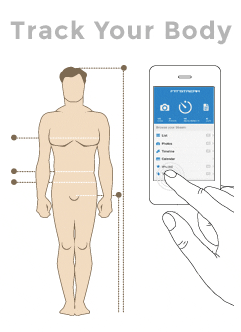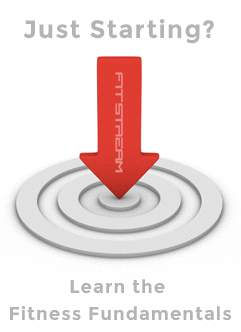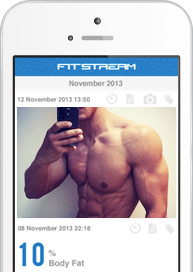"Great souls have wills; feeble ones have only wishes"
Chinese Proverb

In this article we give you four steps on how to create the perfect plan to achieve your fitness goals.
Whatever your aim, from losing weight, to building muscle, there are quick and effective techniques that really help.
Don't worry, we're not talking Gantt charts and process flows here. Just four simple planning techniques that bring clarity to what you're working towards and ensure that you're going about it in the right way.
Why should you plan your fitness?
You understand that ad hoc, aimless training is a waste of time and a fitness plan will solve this problem.
You can't train aimlessly, without intelligent intent and expect to drop two dress sizes or pack on five pounds of muscle mass. Without a plan you have a vague mountain to climb, with no real goals, actions on how to achieve it, or way of measuring progress.
Most people know how they want to look, or how much they want to lift, but aren't sure about how to get there and have no plan driving them forward.
Creating a plan is quick and painless and brings clarity to your training. You know what you want to achieve, how you're going about it, and what progress you've made so far... and suddenly things seem less daunting.
This is also a great motivational tactic because you have something to work towards and measure.
 Our approach to fitness planning is based around four key steps -
Our approach to fitness planning is based around four key steps -
Define. Plan. Track. Refine.
Define your goals. Plan how you're going to achieve them. Monitor progress. Refine your training.
Here is the Fitstream four step model that puts you firmly in control of your fitness...
Step One: Define your overall fitness goal
What is it that you want to achieve?
This is easy - where are you now and where do you want to be?
Nancy Duarte, "Resonate"
All workouts are prompted by goals. You're not out there sprinting, lifting, climbing, pulling and pushing for the hell of it. You want to accomplish something... so, write down your overall goal be it, performance, aesthetic or health related. It doesn't matter, as long as you define something that's a powerful, motivating aim, that will get you out of bed in the morning and into the gym.
Once you have your overall goal defined you break this down into a series of more specific sub-goals to help create your fitness roadmap.
Breaking your primary goal down has a positive mental effect by making the task seem less daunting and easier to achieve. This process also allows you to truly acknowledge what you're trying to accomplish and how you'll go about it.
Ensure your sub-goals are concrete, measurable and time-based rather than vague, woolly or high-level. If weight loss is your goal, state how much weight you want to lose. Know clearly what the goal is, i.e., what exactly your target weight might be and how many pounds that means you have to lose to get there.
It can be a difficult balancing act to come up with goals that are both challenging, yet achievable, but this is a skill that comes with experience. We've included some core targets for fat loss and muscle building below, but please note that these can vary wildly. Use them as a guide if you're unsure about where to start and refine them over time:
- Fat loss - 4-6lbs / month
- Muscle building - 1lb / month
Once you've defined your goals you must work out how you're going to achieve them. You do this by creating a fitness plan - a basic guide to get you on the right track. Following these simple planning techniques will significantly increase your chances of realising your fitness goals.
Step Two: Create your fitness plan
How will you achieve your goals?
Your plan outlines how you're going to achieve these goals by assigning activities to objectives. Unless you're experienced you might find it difficult to know how to build your workouts, what exercises to use and all the other aspects of training such as weight, reps, sets, duration, frequency, distance, speed, diet...
Don't try to write your own diet and exercise routine if you're a beginner, and use a professional, tried and tested routine.
Give it time to work and after a month or two, refine the training to suit your needs. Remember that no single routine works blindly for everyone and you should monitor your progress. As you become more experienced and your body responds, so you become more intuitive about how to train to achieve what you want.
Below is an example fitness plan:
- Overall goal: To achieve a healthy body weight and build visible six pack abs
- Sub-goal one: Achieve body fat percentage of 8-10% by July 1st.
- Sub-goal two: Lose 28lbs of body fat by July 1st (average of 5lbs / month)
I will achieve my goals by doing the following, for the next two months:
- Activity one: Bodyweight workout twice per week (Mon / Wed)
- Activity two: Cycling to work each day (18 mile round trip)
- Activity three: Hill sprints for 25 minutes twice per week (Fri / Sun)
- Activity four: Build up to 5 sets of 2 minute long plank exercises (daily)
- Activity five: Limit calorie intake to 2000 / day
Consider building rewards into your plan as you hit each objective as a motivation aid.
Now that you know what it is that you want to achieve and how you're going to do it - you're in control, so start training!
Step Three: Track your progress
How am I progressing?
A sad reality is that most people's fitness training is born from high hopes and expectations and dies in frustration and disappointment. It's important that you maintain a training journal to track your progress and understand what's working for you to make informed judgements on how to adapt your training plan.
How you maintain your journal is up to you. Some people prefer paper-based tracking (in which case, check out this aricle on keeping a fitness journal where you can download and print our template fitness tracker) and others prefer using apps or spreadsheets.
We've spent years building the ultimate fitness journaling platform and body tracking service. Our app is completely free to use and records notes, body measurements and progress pics. All your data is securely stored and you can see progress reports on how you're changing over time.
You can read more and download our fitness journal app across the website.
However you change to measure and track your progress, the key thing is to start today. It helps sustain motivation, keeps you focused and accountable. Your journal will also serve as an important wealth of information that you can rely on time and time again to understand how your body is changing and what works for you.
Finally, success is incremental and arrives slowly, but consistently. It's easy to overlook how you're progressing but keeping a fitness journal puts it in black and white and keeps you informed.
Step Four: Refine your plan
What should I change?
Look at your stats regularly (weekly works for most people) and answer the question - am I on track to meet my goals? If so, that's great! Nothing need change and continue with the plan. If you're off track, then you have a wealth of information in your training journal to help you figure out why.
If you find that you're not making much progress towards a goal, it's time to go back and re-evaluate your tactics and approach.
Maybe the intensity isn't there, or you're not performing the right exercises, or training enough. Drop what's not working for you and add in something new. Question everything and don't be afraid to experiment.
Your body will adapt quickly to the demands placed upon it. Look at your rep ranges, have you outgrown your current plan, do you need more plates adding to that squat, or a weighted vest thrown into the mix for those pull-ups? Keep the challenge in there and intensity high and remain focused on those goals.
Learn from failure
If you've set yourself a difficult goal then it's inevitable that there will be setbacks along the way. The key is persistence and not to let failure put you off track. Successful people differ from others not because they don't experience difficulties, but in how they react in the face of them.
When facing challenges in your training, think over what went wrong and view everything as a learning opportunity.
Fitness Planning Summary
This is all you need... four simple steps to planning out your fitness, maintaining motivation and helping ensure progress towards those goals. Define. Plan. Track. Refine.
Taking the steps outlined in this article helps change "wants" into "goals". "Wants" are aimlessly carried around with you, whereas "Goals" are built on a path of action.











